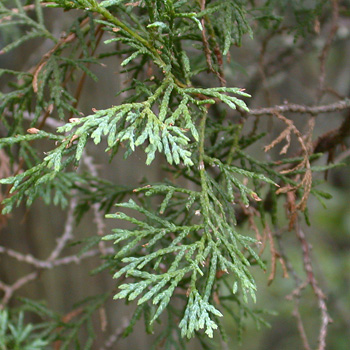

Chamaecyparis thyoides - (image 1 of 5)
Taxonomy
Family: Cupressaceae
Habitat
Swamps and bogs.
Associates
Distribution
Primarily on the coastal plain from southern ME and central NH to FL and MS.
Morphology
Slender, monoecious, evergreen tree to 25 m; branchlets numerous from the axils of the lateral leaves, forming more or less flattened sprays; ultimate branchlets about 1 mm wide; leaves bluish-green, imbricate, scale-like, appressed, ovate, 2-4 mm, pointed, usually glandular, persisting and enlarging on the older branches; cones woody (fleshy when young), 6-8 mm, the scales mostly 6, pointed in the center; seeds winged.
Notes
Cones produced March to April and maturing in the first year
Wetland indicator: OBL
Atlantic white cedar swamps are acidic peatlands dominated by the species but also may contain red maple, black gum, and a great diversity of other understory species. These swamps are often bordered by a thicket of greenbriers (Smilax spp.) making them sometimes difficult to get into.
References
Gleason, Henry A. and A. Cronquist. 1991. Manual of Vascular Plants of
Northeastern United States and Adjacent Canada. Second Ed.
The New York Botanical Garden. Bronx, NY
|
© Michael Hough 2018 |